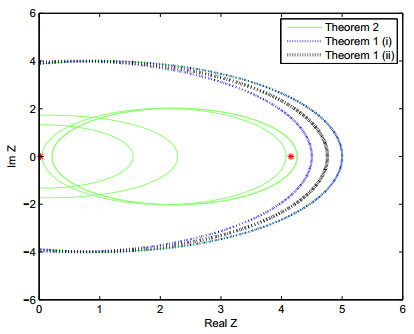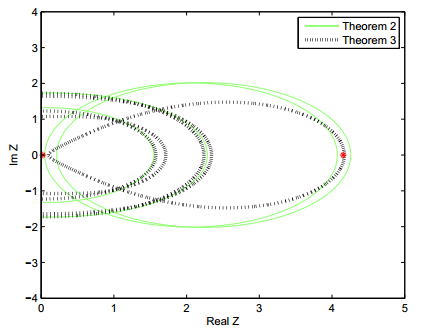1. Introduction
Singular values and the singular value decomposition play an important role in numerical analysis and many other applied fields [3,4,5,6,7,8]. First, we will use the following notations and definitions. Let N:={1,2,…,n}, and assume n≥2 throughout. For a given matrix A=(aij)∈Cn×n, we define ai=|aii|, si=max{ri,ci} for any i∈N and u+=max{0,u}, where
|
ri:=n∑j=1,j≠i|aij|, ci:=n∑j=1,j≠i|aji|.
|
In terms of si, the Geršgorin-type, Brauer-type and Ky-Fan type inclusion sets of the matrix singular values are given in [2,1,9,10], we list the results as follows.
Theorem 1 If a matrix A=(aij)∈Cn×n, then
(ⅰ) (Geršgorin-type, see [1]) all singular values of A are contained in
|
C(A):=n⋃i=1Ci with Ci=[(ai−si)+,(ai+si)]∈R.
|
(1.1)
|
(ⅱ) (Brauer-type, see [2]) all singular values of A are contained in
|
D(A):=n⋃i=1n⋃j=1,j≠i{z≥0:|z−ai||z−aj|≤sisj}.
|
(1.2)
|
(ⅲ) (Ky Fan-type, see [2]) Let B=(bij)∈Rn×n be a nonnegative matrix satisfying bij≥max|aij|,|aji| for any i≠j, then all singular values of A are contained in
|
E(A):=n⋃i=1{z≥0:|z−ai|≤ρ(B)−bii}.
|
We observe that, all the results in Theorem 1 are based on the values of si=max{ri,ci}, if ri≪ci or ri≫ci, all these singular values localization sets in Theorem 1 become very crude. In this paper, we give some new singular values localization sets which are based on the values of ri and ci. The remainder of the paper is organized as follows. In Section 2, we give our main results. In Section 3, some comparisons and illustrative example are given.
2. New inclusion sets for singular values.
Based on the idea of Li in [2], we give our main results as follows.
Theorem 2 If a matrix A=(aij)∈Cn×n, then all singular values of A are contained in
where
|
Γ1(A):=n⋃i=1{σ≥0:|σ2−|aii|2|≤|aii|ri(A)+σci(A)},
|
and
|
Γ2(A):=n⋃i=1{σ≥0:|σ2−|aii|2|≤|aii|ci(A)+σri(A)}.
|
Proof. Let σ be an arbitrary singular value of A. Then there exist two nonzero vectors x=(x1,x2,…,xn)t and y=(y1,y2,…,yn)t such that
Denote
|
|xp|=max{|xi|, 1≤i≤n}, |yq|=max{|yi|,1≤i≤n},
|
and xq is the q-th element in the vector x=(x1,x2,…,xn)t.
The q-th equations in (2.1) imply
|
σxq−¯aqqyq=n∑j=1,j≠q¯ajqyj,
|
(2.2)
|
|
σyq−aqqxq=n∑j=1,j≠qaqjxj.
|
(2.3)
|
Solving for yq we can get
|
(σ2−aqq¯aqq)yq=aqqn∑j=1,j≠q¯ajqyj+σn∑j=1,j≠qaqjxj.
|
(2.4)
|
Taking the absolute value on both sides of the equation and using the triangle inequality yields
|
|σ2−|aqq|2||yq|≤|aqq|n∑j=1,j≠q|¯ajq||yj|+σn∑j=1,j≠q|aqj||xj|≤|aqq|n∑j=1,j≠q|¯ajq||yq|+σn∑j=1,j≠q|aqj||xp|.
|
(2.5)
|
If |xp|≤|yq|, we can get
|
|σ2−|aqq|2|≤|aqq|cq(A)+σrq(A).
|
Similarly, if |yq|≤|xp|, we can get
|
|σ2−|app|2|≤|app|rp(A)+σcp(A).
|
Thus, we complete the proof.
Remark 1 Since
|
|aii|ri(A)+σci(A)≤(|aii|+σ)si,
|
and
|
|aii|ci(A)+σri(A)≤(|aii|+σ)si.
|
Therefore, the inclusion sets in Theorem 2 are always tighter than the inclusion sets in Theorem 1 (ⅰ). That is to say, our results in Theorem 2 are always better than the results in Theorem 1 (ⅰ).
Theorem 3 If a matrix A=(aij)∈Cn×n, then all singular values of A are contained in
where
|
Δ1(A)=n⋃i=1,j=1{σ≥0:(|σ2−|aii|2|−|aii|ci(A))|σ2−|ajj|2|≤σri(A)(σcj(A)+|ajj|rj(A))},
|
|
Δ2(A)=n⋃i=1,j=1{σ≥0:|σ2−|aii|2|(|σ2−|ajj|2|−|ajj|rj(A))≤σcj(A)(σri(A)+|aii|ci(A))}.
|
Proof. Let σ be an arbitrary singular value of A. Then there exist two nonzero vectors x=(x1,x2,…,xn)t and y=(y1,y2,…,yn)t such that
Denote
|
|xp|=max{|xi|, 1≤i≤n}, |yq|=max{|yi|,1≤i≤n}.
|
Similar to the proof of Theorem 2, the q-th equations in (2.6) imply
|
|σ2−|aqq|2||yq|≤|aqq|n∑j=1,j≠q|ajq||yj|+σn∑j=1,j≠q|aqj||xj|≤|aqq|n∑j=1,j≠q|ajq||yq|+σn∑j=1,j≠q|aqj||xp|.
|
(2.7)
|
That is,
|
(|σ2−|aqq|2|−|aqq|n∑j=1,j≠q|ajq|)|yq|≤σn∑j=1,j≠q|aqj||xp|.
|
(2.8)
|
If |xp|≤|yq|, the p-th equations in (2.6) imply
|
0≤|σ2−|app|2||xp|≤(σn∑j=1,j≠p|ajp|+|app|n∑j=1,j≠p|qpj|)|yq|.
|
(2.9)
|
Multiplying inequalities (2.8) with (2.9), we have
|
(|σ2−|aqq|2|−|aqq|cq(A))|σ2−|app|2|≤σrq(A)(σcp(A)+|app|rp(A)).
|
Similarly, if |xp|≥|yq|, we can get
|
|σ2−|aqq|2|(|σ2−|app|2|−|app|rp(A))≤σcp(A)(σrq(A)+|aqq|cq(A)).
|
Thus, we complete the proof.
We now establish comparison results between Δ(A) and Γ(A).
Theorem 4 If a matrix A=(aij)∈Cn×n, then
Proof. Let z be any point of Δ1(A). Then there are i,j∈N such that z∈Δ1(A), i.e.,
|
(|z2−|aii|2|−|aii|ci(A))|z2−|ajj|2|≤zri(A)(zcj(A)+|ajj|rj(A)).
|
(2.10)
|
If zri(A)(zcj(A)+|ajj|rj(A))=0, then
|
|z2−|aii|2|−|aii|ci(A)=0,
|
or
Therefore, z∈Γ1(A)⋃Γ2(A). Moreover, If zri(A)(zcj(A)+|ajj|rj(A))>0, then from inequality (2.10), we have
|
|z2−|a2ii||−|aii|ci(A)zri(A)|z2−|a2jj||zcj(A)+|ajj|rj(A)≤1.
|
(2.11)
|
Hence, from inequality (2.11), we have that
|
|z2−|a2ii||−|aii|ci(A)zri(A)≤1,
|
or
|
|z2−|a2jj||zcj(A)+|ajj|rj(A)≤1.
|
That is, z∈Γ1(A) or z∈Γ2(A), i.e., z∈Γ(A). Similarly, if z be any point of Δ2(A), we can get z∈Γ(A).
Thus, we complete the proof.
Example 1. Let
The singular values of A are σ1=4.1544 and σ2=0.0241. The singular value inclusion sets C(A), D(A), Γ(A) and the exact singular values are drawn in Figure 1. From Figure 1, we can say, all the singular values are contained in the singular value inclusion sets C(A), D(A), Γ(A), but the inclusion sets Γ(A) are more tighter than the inclusion sets C(A), D(A). That is to say, the results in Theorem 2 are better than the results in Theorem 1 for certain examples.
The singular value inclusion sets Γ(A), Δ(A) and the exact singular values are drawn in Figure 2. From Figure 2, we can say, all the singular values are contained in the singular value inclusion sets Γ(A), Δ(A), but the inclusion sets Δ(A) are more tighter than the inclusion sets Γ(A). That is to say, the results in Theorem 3 are always better than the results in Theorem 2, which are shown in Theorem 4.
3. Conclusion
In this paper, some new inclusion sets for singular values are given, theoretical analysis and numerical example show that these estimates are more efficient than recent corresponding results in some cases.
Acknowledgements
He is supported by Science and technology Foundation of Guizhou province (Qian ke he Ji Chu [2016]1161); Guizhou province natural science foundation in China (Qian Jiao He KY [2016]255); The doctoral scientific research foundation of Zunyi Normal College (BS[2015]09). Liu is supported by National Natural Science Foundations of China (71461027); Science and technology talent training object of Guizhou province outstanding youth (Qian ke he ren zi [2015]06); Guizhou province natural science foundation in China (Qian Jiao He KY [2014]295); 2013, 2014 and 2015 Zunyi 15851 talents elite project funding; Zhunyi innovative talent team (Zunyi KH (2015)38). Tian is supported by Guizhou province natural science foundation in China (Qian Jiao He KY [2015]451);Scienceand technology Foundation of Guizhou province (Qian ke he J zi [2015]2147). Ren is supported by Science and technology Foundationof Guizhou province (Qian ke he LH zi [2015]7006).
Conflict of Interest
All authors declare no conflicts of interest in this paper.










 DownLoad:
DownLoad: 




